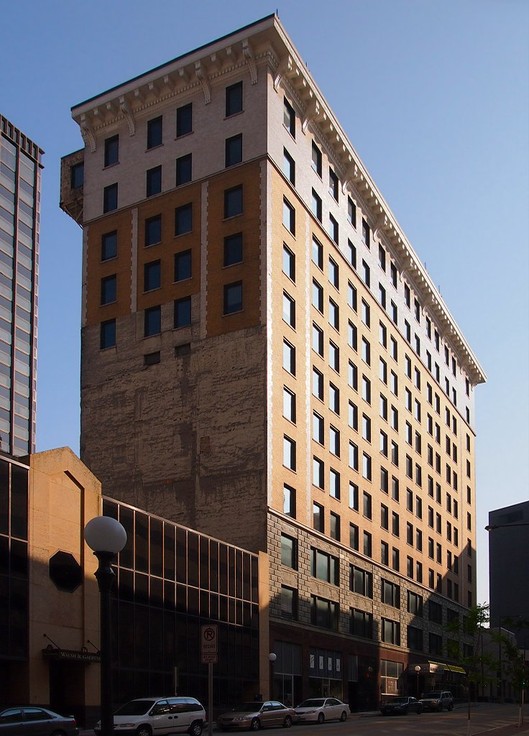Commerce Building in St. Paul, Minnesota
Introduction
Text-to-speech Audio
Images
Commerce Building in St. Paul. The building opened in 1912 and transitioned into an apartment complex in 2008.

Backstory and Context
Text-to-speech Audio
Opened in 1912, St. Paul's Commerce Building initially served the Commercial Club of St. Paul (established, 1891) and the offices of the St. Paul Association of Commerce. During the Gilded Age, most large urban centers had at least one formal commercial organization by the 1880s, which later evolved into Boards of Trade and Chambers of Commerce later on during the twentieth century. Commercial Clubs mainly looked to maintain a civic culture that proved friendly to businesses. The building stands as a reminder to a time when cities competed for commercial growth, as well as a period where St. Paul proved more slightly more attractive to businesses than its neighbor, Minneapolis.
The period between 1880 and 1920 saw the addition of many new building types to downtown St. Paul. The skyscraper, while functional, also served as a sign of success, influence, and prominence. Minneapolis and St. Paul were in direct competition -- often as bitter rivals -- for new business, especially for convention business. Yet, for the vast majority of those forty years, St. Paul led the state in establishing relationships that advanced its commercial and economic prosperity, taking advantage of the city's proximity to the State Capitol.
The St. Paul Commercial Club formed in 1891, and in 1909 its members announced an intention to build a new headquarters. Not only was a centralized located desired, but also a consolidated organization. In 1911, the St. Paul Commercial Club and St. Paul Association of Commerce were among the nation's first to merge its organizations into a single building. However, the Commercial Club continued to function as an independent association after the merger. The Commercial Club members hired architect Hermann Kretz to design the new building. Construction of this historic building began in 1911, and its completion arrived quickly because the builders used slabs and reinforced concrete.
The Commercial Club enjoyed many amenities such as an ornate main lobby, ladies' reception room, card room, banquet room, tea room, secretaries office, check room, billiard room, dining hall, and private dining rooms. The club quarters also enjoyed plenty of decor marked by fumed oak, silver oak, burnt cypress, and old ivory intermingled with oriental rugs, upholstered furniture, Spanish leather, and tapestries.
The grand opening of the Commercial Club was on September 9, 1912, followed by a week of festivities near the building. But, ten years after opening, during a time of economic decline from 1921-1923, the St. Paul Association of Commerce decided to forgo renewing its lease and moved out of the Commerce Building. During the Great Depression, tenant losses mounted in the building, and Minneapolis overtook St. Paul as the power-center for commercial activity. During the Depression and World War II, downtown construction slowed dramatically, and, during the 1950s, urban renewal projects led to the demolition of many nineteenth-century buildings; the Commerce Building was one of the few to survive. As is often the case with older downtown buildings during the late twentieth and twenty-first century, the building transitioned into an apartment complex in 2008.
Sources
DeCarlo, Peter J. "Commerce Building, St. Paul." Minnesota Historical Society. mnopedia.org. March 28, 2018. https://www.mnopedia.org/structure/commerce-building-st-paul
Wingerd, Mary Lethert. Claiming the City: Politics, Faith, and the Power of Place in St. Paul. Ithica, New York: Cornell University Press, 2001.
Zellie, Carole S. and Amy M. Lucas. "Nomination Form: Commerce Building." National Register of Historic Places. nps.gov. March 6, 2007. https://npgallery.nps.gov/GetAsset/1f74de72-8332-4cb1-922b-4f7b80e84530
By McGhiever - Own work, CC BY-SA 3.0, https://commons.wikimedia.org/w/index.php?curid=27344346
